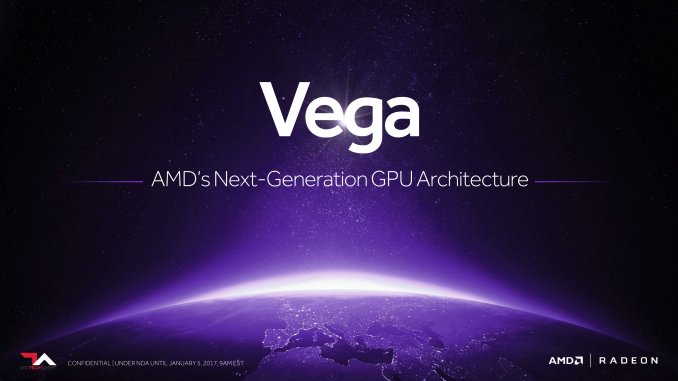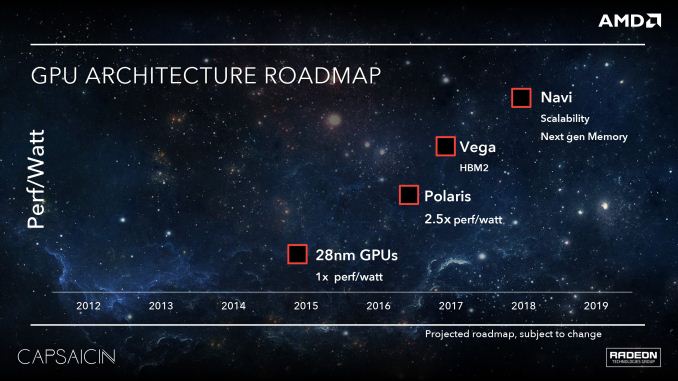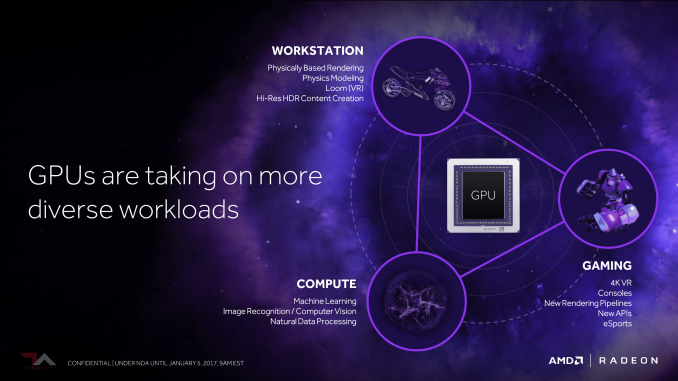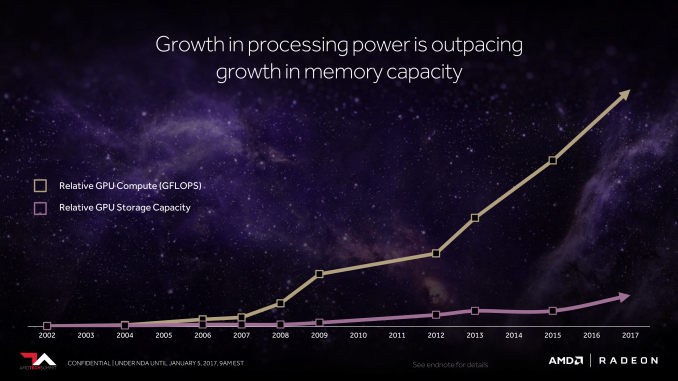The AMD Vega GPU Architecture Teaser: Higher IPC, Tiling, & More, Coming in H1’2017
by Ryan Smith on January 5, 2017 9:00 AM EST
As AMD was in the process of ramping up for the Polaris launch last year, one of the unexpected but much appreciated measures they took was to release a bare-bones GPU architecture roadmap for the next few years. AMD has traditionally held their cards very close to their proverbial chest on what they’re working on next, typically only announcing a new architecture weeks before it’s set to launch in retail products. Polaris itself was a departure from that, as it was announced a good 5 months in advance, but last year’s roadmap was the first honest-to-goodness look we’ve had at AMD’s long-term plans in a long time.
What did that map show us? After 2016’s Polaris would come Vega, and after that would be Navi. As a high-level roadmap it didn’t show us much – in fact other than a timeframe, the only detail attached to Vega was “HBM2” - but it was enough to help understand one of the things AMD would be doing architecturally to set Vega apart from Polaris. As for the timeframe itself, that was ambiguous at best in AMD’s roadmap. But now as we draw closer to the launch of Vega, the picture has become clearer. AMD will be hitting a yearly cadence with Vega. The first chip, which tapped out last year, will be launching in the first half of this year (H1’17).
To that end, with Vega’s launch not too far over the horizon, AMD is ready to start talking about what will be their next GPU architecture. Last year at this time we got our first real glimpse into Polaris and what would become the Radeon RX 480/470/460, and this year AMD is back again with a teaser of things to come with Vega.
Setting The Stage: Expectations Management; Less How & More Why
Before we dive into any architectural details, perhaps it’s best we first set the stage. This goes for both what to expect of today’s announcement, and to better understand what AMD is doing and why.
First and foremost, today’s detail release is a teaser, not a deep dive, or even a preview. AMD is only releasing a few details about Vega, and those are being kept at a high level. In fact it’s fair to say that there’s just enough information to answer little and raise even more questions; just what a proper teaser should be.
Why? Well part of the reason is that we’re still months off from the launch of Vega. I believe it’s fair to say that by announcing a first-half of the year launch date when we’re already in 2017 is a strong indicator that Vega will not launch until later in that window, likely some time in Q2. So we’re still a good three to five months out from the launch of Vega, which means AMD doesn’t want to (or need to) release too many details this far out. Rather they can trickle out chosen details for maximum impact.
At the same time the AMD of 2017 has more they can focus on in the high-performance space than just GPUs. Ryzen launches soon, and they also have other products on the horizon such as the Radeon Instinct accelerators. Polaris received as much detail as it did because it was all AMD really had to talk about, and they needed to recover from a rough 2015 where AMD’s at-the-time power efficiency woes were brought into full focus. But now Vega can share the stage with Ryzen and other products, and that lets AMD be more selective about what they say.
All of which is something I would argue is a good thing. At the end of the day Polaris was an optimized version of the GCN 1.2 (aka GCN 3) architecture for GlobalFoundries’ 14nm FinFET process. The resulting GPUs were solid competitors in the mainstream and value markets, improving on AMD’s power efficiency in a way they badly needed. But they weren’t high-end parts; they didn’t excite like those parts did, and for technology enthusiasts they didn’t significantly change the architecture itself (in fact GCN 4 was ISA compatible with GCN 3, something that doesn’t happen a lot in the GPU space). AMD talked big about Polaris – perhaps too big – and I do think it hurt them in some circles once it became clearer that this was AMD catching up. Which is not to say that AMD’s marketing arm won’t talk big about Vega as well, but they need not ride the technology angle so hard. Vega is a launch that can be more natural and more subdued, especially as at this point we know AMD is aiming big with a much-needed new generation of high-end parts.
In any case, as AMD isn’t riding the technology angle quite as hard in this year’s teaser, they are spending a bit more time explaining the market and some of the logic behind Vega’s design. For its teasing debut, Vega is little less discussion of “how,” and a little more conversation of “why”.
So what is AMD looking to do with Vega? Besides aiming for the high-end of the market, AMD is looking at how the market for GPUs has changed in the last half-decade, and what they need to do to address it. Machine learning is one part of that, being a market that has practically sprung up overnight to become a big source of revenue for GPUs. This is where the previously announced Radeon Instinct will fit in.
But more than that, it’s about fundamental shifts in how workloads are structured. GPU performance growth has far outpaced GPU memory capacity. Scene geometry complexity has continued to grow. Newer rendering methods have significantly changed GPU memory access patterns.
To that end, AMD is looking to address all of these factors with Vega. Which is not to say that this is everything – this is a teaser, after all – but this is where AMD is starting. Where they are going to be with their next generation architecture and how they believe it will address the changes in the market. So without further ado, let’s take a teasing look at what the future has in store for AMD’s GPUs.













155 Comments
View All Comments
jjj - Thursday, January 5, 2017 - link
599$ for Titan X Pascal (or better) perf?nathanddrews - Thursday, January 5, 2017 - link
If they have TitanXP performance, it's going to be more expensive than the 1080. You know NVIDIA is just waiting for a chance to release a $699 or $799 1080Ti, so whatever AMD brings out, you can bet there's gonna be a clash of titans. Er, titans and stars, that is.jjj - Thursday, January 5, 2017 - link
599$ might be too aggressive but depends on where the die size lands and what Nvidia does.Vega has almost 15% more FLOPS than Titan XP so remains to be seen how well they utilize that computing power and how much silicon it takes.
The likely 8GB of HMB does help on the cost side.
It also depends on what other SKUs they got and when. A high price limits volumes but if they also have lesser SKUs at launch, they can afford to price the best SKU higher.
haukionkannel - Thursday, January 5, 2017 - link
True! Nvidia has guaranteed that fastest Vegas can be sold over 1000$...Lets hope that cheaper option are near 500-600$.
The interesting part is when AMD will use these next generation GPU units in their mid and low range products. Maybe the next summer or next autumn? Then we will get interesting devices to 150-350$ slots! Most propably with gdd5 in the low end and maybe gddr5+ in the high mid range GPUs,
jjj - Thursday, January 5, 2017 - link
Why not get a 350$ card at launch. They have nothing above Polaris 10 and the 350 price band is important.eachus - Saturday, January 14, 2017 - link
There is a new Polaris chip (Polaris 12) in the works. It may be intended only for APUs where it would be mounted on an interposer with a Ryzen chip. It is not clear what AMD is going to do in the gap between RX 480 and Vega 10. Vega 11 is expected to replace the RX 480** Understand what replace means here. It doesn't mean that AMD will stop selling Polaris GPUs. It means that AMD expects Vega 11 to have a better price/performance than RX 480, and that the performance gap between and that the price range where RX 480 currently sells will be starved of oxygen. I do expect a dual Polaris 10 card to ship, and there is also an RX 490 design floating around. (It may be a Polaris 10 chip with a higher clock speed, more power of course, and 8 Gig of GDDR5x memory.)
Always remember that marketing gets the last say, not engineering. So only one or none of these products may show up. It is also not clear when Vega 11 will arrive. If it is late in this year, or early in next year, there will be enough time to market the additional Polaris parts.
Jad77 - Thursday, January 5, 2017 - link
So, by the time this hits the streets, Nvidia will already have another hardware iteration out? It's likely too late, but if you still holding on, sell your AMD stock.Darkknight512 - Thursday, January 5, 2017 - link
Likely Nvidia will have an answer, that has always been the case and is barely even worth mentioning anymore, at least until AMD gets the upper hand one of these days. They did it to Intel during the Athlon days. It is very much possible, they have smart engineers, they just don't have enough of them but that often does not matter if they can work more efficiently. They have one thing going for them and that is a larger team by 2x often results in <2x the work done.One of my former bosses while I worked in the silicon industry said "AMD has good technology, they just have terrible luck being the underdog in both industries they compete in at the same time.". I wholely agree, with some luck they actually can come out on top, Nvidia is spending a lot of money diversifying.
MLSCrow - Thursday, January 5, 2017 - link
Honestly, I for once, don't think nVidia will have an answer. I feel that their expectations of what AMD could do were so incredibly low, that they felt GP100 and all of its derivatives would be enough to lay the smack down on AMD for good. Even with Volta, which seems like it's going to be a slight tweak to Pascal, it seems that Vega might just come out on top, which would make more sense out of AMD's slide of "Poor Volta", which would be a rather idiotic move unless AMD truly had something to be that cocky about.Yojimbo - Thursday, January 5, 2017 - link
NVIDIA isn't trying to lay the smackdown on AMD for good. NVIDIA has been evolving in a different direction from AMD. AMD, probably because they have been cash-strapped, has not been able to invest the money necessary to become a platform-based company the way NVIDIA has.Also, Volta will not be a small tweak to Pascal. Pascal was a die shrink and small tweak to Maxwell (from the point of view of the underlying architecture, not the features that it enables). Volta is supposed to have ~1.7 times the performance and efficiency of Pascal on the same process technology. It won't be out until 6 to 9 months after Vega, however. But I'm very leery about taking AMD's promises at face value. Even if Vega is as high performance and efficient as AMD claims, it still uses HBM2 which adds significant cost to the manufacture of the chip. That means they will only be able to put a limited amount of pricing pressure on NVIDIA.